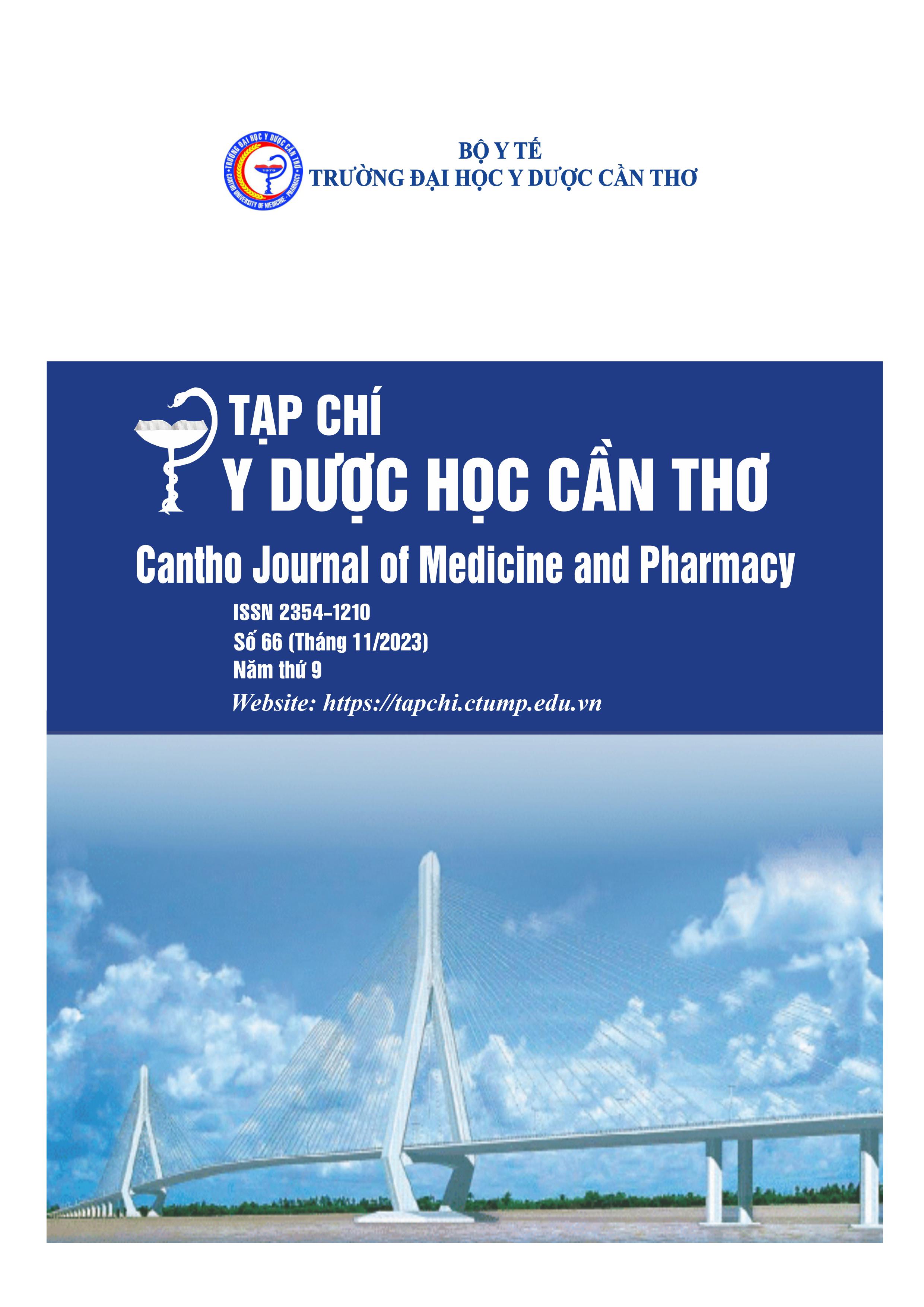RESEARCH SITUATION OF DENGUE VIRUS INFECTION AND SOME RELATED FACTORS IN PEDIATRIC PATIENT WITH SERVERE DENGUE HEMORRHAGIC FEVER AT CAN THO CHILDREN'S HOSPITAL IN 2022-2023
Main Article Content
Abstract
Background: Dengue hemorrhagic fever was an acute infection caused by the Dengue virus and each type had different severity. Objective: 1). Dengue virus infection rate. 2). Evaluation of treatment results. 3). The relationship of Dengue virus type with clinical and subclinical. Materials and methods: A cross-sectional descriptive study was conducted on 84 pediatric patient treated at Can Tho Children's Hospital, diagnosed with severe Dengue hemorrhagic fever according to the standards of the Ministry of Health in 2023. Results: Virus types Dengue 2 (46.4%), Dengue 1 (10.7%), Dengue 4 (4.8%), Dengue 3 (0%), overall treatment results 97.7%, mortality 2.3 %, symptoms of vomiting 83.3% (p=0.01), abdominal pain 82.9% (p=0.02), and hepatomegaly with 81.4% (p=0.03) were more common in Dengue 2 type than in other types. Type Dengue 2 had increased creatinine 57.6 ± 16.6 (p=0.046), leukopenia 3645 ± 317.7 (p=0.039) and increased hematocrit 46.9 ± 4.3 (p=0.005). Dengue 1 and Dengue 4 types increased urea levels higher than Dengue 2 type with 3.9 ± 1.9 (p=0.046). Conclusion: Dengue type 2 accounts for the highest rate at 46.4%, with a cure rate of 97.7%. The concentration of urea in the Dengue 1 and Dengue 4 groups increased (3.9 ± 1.9) compared with the Dengue 2 group. Dengue 2 had increased creatinine (57.6 ± 16.6), leukopenia (3645 ± 317.7), increased hematocrit (46.9 ± 4.3) compared with Dengue 1 and Dengue 4. Clinical symptoms such as vomiting (83.3%), abdominal pain (82.9%) hepatomegaly (81.4%) in Dengue 2 is higher than Dengue 1 and Dengue 4.
Article Details
Keywords
Dengue hemorrhagic fever, Dengue virus type, clinical and subclinical symptoms, relationship, shock
References
2. Trần Thanh Hải và Tạ Văn Trầm. Mối Tương Quan Giữa Đặc Điểm Lâm Sàng, Cận Lâm Sàng Với Týp Và Nồng Độ Virút Dengue Trong Sốt Xuất Huyết Dengue Trẻ Em, Tạp Chí Y Dược Học Cần Thơ (11). 2018.
3. Nguyễn Đức Thuận và Đặng Thành Chung. Nghiên Cứu Tỉ Lệ Type Virus Dengue Ở Bệnh Nhân Nhi Trong Một Số Đợt Dịch Tại Khu Vực Miền Nam Việt Nam, Tạp chí Y học Việt Nam. 2021. 503(1). https://doi.org/10.51298/vmj.v503i1.695
4. Bộ Y tế. Dengue virus Real-time RT-PCR, Bộ Y tế, Quyết định số 6769/QĐ-BYT ngày 08 tháng 11 năm 2018 về việc ban hành tài liệu hướng dẫn quy trình kỹ thuật chuyên ngành Vi sinh của Bộ trưởng, chủ biên, Hà Nội, 2018.160-163.
5. Võ Duy Minh và Phùng Nguyễn Thế Nguyên. Đặc Điểm Lâm Sàng Và Điều Trị Sốc Sốt Xuất Huyết Dengue Ở Trẻ Em Tại Bệnh Viện Nhi Đồng 1 Từ 2019-2020, Tạp Chí Y Học Việt Nam. 2021. 509(1). https://doi.org/10.51298/vmj.v509i1.1776.
6. Nguyễn Ngọc Rạng và Lâm Thị Huệ. Các Chỉ Số Xét Nghiệm Tiên Đoán Sốt Xuất Huyết Dengue Nặng Tại Bệnh Viện Nhi Đồng Cần Thơ, Tạp Chí Y Dược Học Cần Thơ (34). 2021.
7. Nguyễn Thị Tuyết Vân và cộng sự. Sự lưu hành của các týp huyết thanh vi rút dengue gây bệnh sốt xuất huyết tại khu vực Tây Nguyên giai đoạn 2003 - 2020, Tạp chí Y học Dự phòng. 2022. 32(2 Phụ bản), 64-69. https://doi.org/10.51403/0868-2836/2022/609.
8. Hà Quốc Việt và Trương Ngọc Phước. Khảo Sát Mối Liên Quan Giữa Lâm Sàng, Cận Lâm Sàng Với Típ Vi Rút Dengue Và Đánh Giá Kết Quả Điều Trị Sốt Xuất Huyết Dengue Nặng Ở Trẻ Em, Tạp Chí Y Dược Học Cần Thơ (29). 2021.
9. Suppiah, J. et al. Clinical manifestations of dengue in relation to dengue serotype and genotype in Malaysia: A retrospective observational study, PLoS Negl Trop Dis. 2018. 12(9), e0006817. https://doi.org/10.1371/journal.pntd.0006817.
10. Dhanoa, A. et al. Impact of dengue virus (DENV) co-infection on clinical manifestations, disease severity and laboratory parameters, BMC Infect Dis. 2016. 16(1), 406. https://doi.org/10.1186/s12879-016-1731-8.
11. Lau, L. et al. Antibody avidity following secondary dengue virus type 2 infection across a range of disease severity, J Clin Virol. 2015. 69, 63-7. https://doi.org/10.1016/j.jcv.2015.06.003.


